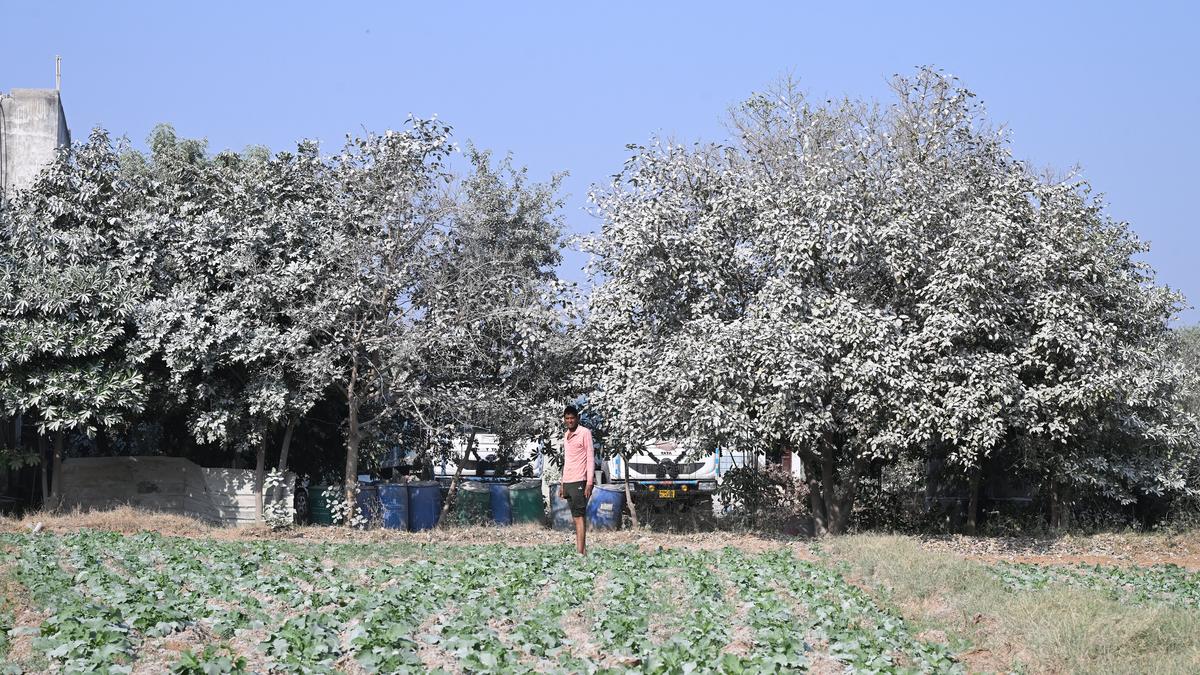
Living under a dust blanket
The Hindu
Old banyan tree in Haryana village bears silent testimony to pollution from stone crushers, affecting residents' health and livelihoods.
On the outskirts of Khatoli Ahir village in Haryana’s Mahendragarh, an old banyan tree, spread with age, is covered with a thick layer of fine grey dust. Not far from the State boundary of Rajasthan, the tree that appears snow-clad, bears silent testimony to the ordeal of thousands of families across a dozen villages in the region. Here, people are constantly exposed to the harmful dust and noise emanating from the scores of stone crushers running with never a pause.
Seated on a cemented platform below the tree, 60-year-old Gyarsi Lal, diagnosed with tuberculosis a year ago, is resigned to his fate. “Court mein case jeet liya. Mamla Supreme Court tak chala gaya. Phir bhi band nahi hue. Hamari kya aukat hai. Hum to mazdoor hain; hamari koi nahi manega (We won the case in court. The matter went to the Supreme Court, yet these units did not shut down. What is our status? We are labourers; no one will listen to us),” says Lal.
His family is among the 80-odd Scheduled Caste families in Khatoli Ahir, who were allotted free plots by the Haryana government on panchayat land on the outskirts of the village in 2012. This was under the Indira Gandhi Awas Yojana, a social welfare programme to give marginalised communities free land.
Of these, only about 20 families shifted into houses they constructed on these plots. They are the worst hit with a crusher unit across the road from where they stay. “This crusher was set up in 2019. It has been five years. It stops only when there is a power cut. We keep the doors and windows shut, but the dust enters through the cracks. Everything inside, even the utensils in the kitchen, remain covered with layers of dust. We don’t just breathe this dust in, but also end up eating it,” says Suresh Kumar, sitting next to Lal. He claims that tuberculosis has claimed two lives. “Sab dus saal pehle mar jayenge (Everyone will die 10 years earlier),” he adds.
After villagers went to court in 2018 against the crushers, Mahendragarh district officials submitted a joint committee report before the National Green Tribunal (NGT) in 2019, saying there were 158 crushers in the district. “Following this, the NGT ordered closure of 72 units. But another report two years later said there were 162 crushers with 107 in Nangal Choudhary sub-division,” says Tejpal Yadav, 32, who belongs to Khatoli Jaat village, but works as a teacher of mathematics at an IIT coaching institute near Jaipur in Rajasthan.
He has been fighting against the crushers both inside and outside court for almost a decade. He says that there were only three or four villages with crusher zones in Nangal Choudhary in 2015, but by 2021 they were spread across 10 villages.
The Regional Officer of the Haryana State Pollution Control Board, Mahendragarh, Krishan Kumar, claims there are currently only 81 stone crushers in the district. “Many crushers have shut down in compliance with the Supreme Court and NGT orders,” he says, adding the department also shut some down for violations. He says there are regular inspections and units are fined if they are found not complying.

The Karnataka government has drafted a comprehensive master plan for the integrated development of Kukke Subrahmanya temple, the State’s highest revenue-generating temple managed by the Hindu Religious Institutions and Charitable Endowments Department. The redevelopment initiative is estimated to cost around ₹254 crore and aims to enhance infrastructure and facilities for devotees.












